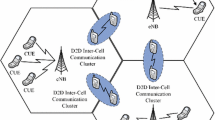Abstract
The current development of mobile communication devices and the use patterns of these devices feature streaming services based on videos rather than services based on text data, images, and voice, as emphasized in the past. Hence, the amount of mobile traffic used by mobile communication device users has increased exponentially. The 5th generation (5G) mobile network technology offers several advantages compared to the existing 4th generation long-term evolution system technology, such as a capacity of data traffic greater by 1000 times, low latency, high energy efficiency, and cost efficiency. However, it cannot be easily provided compared with the latter because the use of a high frequency domain results in path loss. Hence, various technologies have been developed. This study proposes a hybrid method for applying both small cell and device-to-device (D2D) communication technologies for enhancing the performance of 5G mobile communication systems. Moreover, the performances of macro systems applying small cell technology, D2D communication technology, and the proposed hybrid method are compared. The analysis results indicated that the system performance was improved by using small cells and D2D in 5G mobile communication systems and overcoming the disadvantages of shadow areas and path loss issues, and the performance of 5G communication could be drastically enhanced by applying the algorithms of the small cell and D2D technologies as well as the hybrid algorithm between the two technologies.















Similar content being viewed by others
References
Jagadeesha RB, Sheu J-P, Hon W-K (2017) User satisfaction based resource allocation schemes for multicast in D2D network. In: European conference on networks and communications, pp 12–15
Lee Y-J, Lee S-H, Lee S-H, Hwang S-H (2017) Comparison of domestic and foreign trends on 5G system. Korea Institute of Communication Sciences, p 272
Cudak M (2016) Towards making 5G a reality. IEEE 5G summit
Nokia (2016) White paper on the 5G use cases and requirements
Mishra PK, Kumar A, Pandey S (2017) Minimum interference based resource allocation method in two-hop D2D communication for 5G cellular networks. In: Proceeding of the international conference on intelligent sustainable systems
Small Cell Forum (2014) Small cells, what’s the big idea? Technical report, No SCF030
Ge X, Tu S, Mao G, Wang C-X, Han T (2016) 5G ultra-dense cellular networks. IEEE Wirel Commun 23:72–29
Kim S-J, Bae S-H (2017) Performance analysis of mobile data offload using LIPA in femtocell networks. J Korea Inst Inf Electron Commun Technol 56:16–22
5G Forum (2019) 2019 5G small cell ecosystem white paper, p 37
Kim Y-H, Kim T-Y, Lee D-Y, Bae S-H (2020) Analysis of small cell technology application for performance improvement in simulation-based 5G communication environment. Smart Media J 9(2)
Gandotra P (2016) Device-to-device communication in cellular networks: a survey. J Netw Comput Appl 71:99–117
Zhang H, Liao Y, Song L (2017) Device-to-device communications in unlicensed bands for 5G system. IEEE Trans Wirel Commun 16:3507–3519
Kang G-M, Shin O-S (2013) Resource allocation scheme based on spectrum sensing for device-to-device communications under laying cellular networks. J Korean Inst Commun Inf Sci 898–907
Nardini G, Stea G, Virdis A, Sabella D, Caretti M (2016) Broadcasting in LTE-Advanced networks using multihop D2D communications. In: IEEE 27 annual IEEE international symposium on personal, pp 1–6
Monserrat JF, Mange G, Braun V, Tullberg H, Zimmermann G, Bulakci O (2015) METIS research advances toward the 5G Mobile and wireless system definition, no. 53
Acknowledgements
This research was supported by the National Research Foundation of Korea (NRF) grant funded by the Korea government (MSIT) (No. 2019R1F1A1041186).
Author information
Authors and Affiliations
Corresponding author
Additional information
Publisher's Note
Springer Nature remains neutral with regard to jurisdictional claims in published maps and institutional affiliations.
Rights and permissions
About this article
Cite this article
Kim, YH., Bae, SH., Kwon, CH. et al. Analysis of Application of Small-Cell and D2D Communication Technology to Improve Performance in 5G Communication Environment. J. Electr. Eng. Technol. 17, 1347–1356 (2022). https://doi.org/10.1007/s42835-021-00935-x
Received:
Revised:
Accepted:
Published:
Issue Date:
DOI: https://doi.org/10.1007/s42835-021-00935-x




